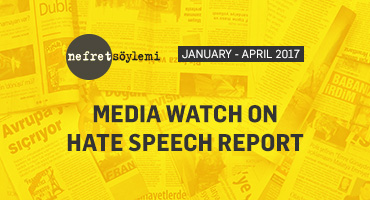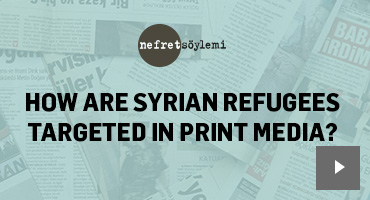Hate Speech and Discriminatory Discourse in Media 2017 Report is prepared in the scope of Media Watch on Hate Speech project, includes along with annual results along with quantitative and qualitative analyses of hate speech data for 2017 and two discriminatory discourse reports entitled Giaour Discourse in Print Media and Discrimination against Syrian Refugees in Media: Misinformation and Distortion which focuses on two topics that stood out in 2017.
Click here to read the full report.
CHAPTER I: HATE SPEECH IN 2017 IN PRINT MEDIA OF TURKEY
5296 columns and news articles targeting national, ethnic and religious groups were found in 2017. Since 186 publications generated hate speech against more than one group in different categories, these articles are analyzed in accordance with the number of featured groups/categories (more than once). Thus, the total number of analyzed items reached 5482. In all these analyzed content, 6782 hate speech items against 79 groups had been found.

Click for accessing all articles and columns that are identified to contain hate speech:
CHAPTER II: 2017 DISCRIMINATORY DISCOURSE REPORTS
The report titled Giaour Discourse in Print Media examines how the word ‘giaour’ is used, which has various historical, sociological and linguistic connotations, in a context within which non-Muslim identities are associated with mercilessness, cruelty and enmity. We tried to reveal how the usage of the word ‘giaour’, in daily life and media alike, isolates non-Muslims living in Turkey and put them in a fragile position by alienating them.
The report is opened by sociologist Arus Yumul’s article in which she discusses the historical and social background of the ‘giaour’ discourse and etymology of the word. This article is followed by an analysis regarding how this discourse is constructed in print media on the basis of religious references and perception of enmity coming from the past. This analysis, which discusses news articles and columns targeting non-Muslims in Turkey and Western states, ends with a discussion on the expression ‘giaour Izmir.’ In the second chapter, the usage of the word ‘giaour’ is discussed in terms of how and in which context it was used as a political propaganda tool in the process leading to the referendum. After the third chapter, which focuses on the article criticizing the ‘giaour’ discourse, the report ends with the conclusion summarizing the report.
The report titled Discrimination against Syrian Refugees in Media: Misinformation and Distortion which is issued in a time when hate speech, discriminatory assumptions and even violent actions against Syrians are on the rise, analyzes how distortion, claims and misinformation in news articles concerning Syrian refugees incite and spread discrimination against those people.
The report opens with an article by Şenay Özden who does research on immigration and migration. The article discusses the legal status of Syrians, the ‘guest’ discourse concerning Syrian refugees and how the discourse constitutes an obstacle to a rights-based approach to refugees. After, the common features of the news articles in which the presence of refugees is presented as a problem and spreading discriminatory judgements are summarized. Following that, the examples that create a distorted ‘Syrian’ image are analyzed in three groups. In the first group, the articles that are reproducing the statements of political figures who have the power of affecting public opinion, using Syrians as a political tool are analyzed. In the second part, articles that mark Syrians as the cause of social and economic problems by concealing the actual reason are analyzed. In the third part, media’s role in the atmosphere of ‘fear,’ which is created by repeatedly associating Syrian identity with crime in articles covering criminal incidents is discussed. After the analyses of selected articles adopting a rights-based approach, the report ends with conclusion and evaluation chapters.




